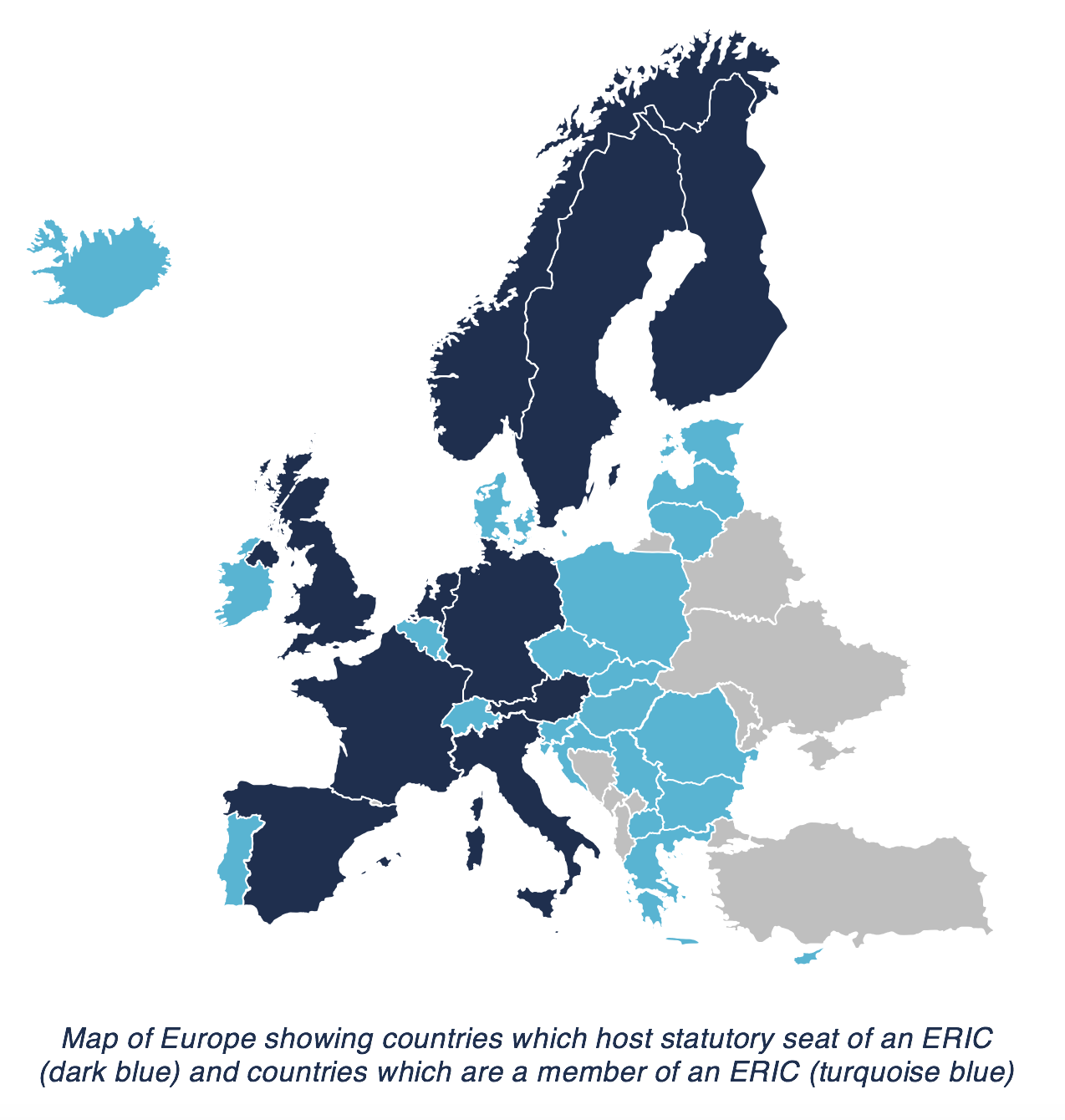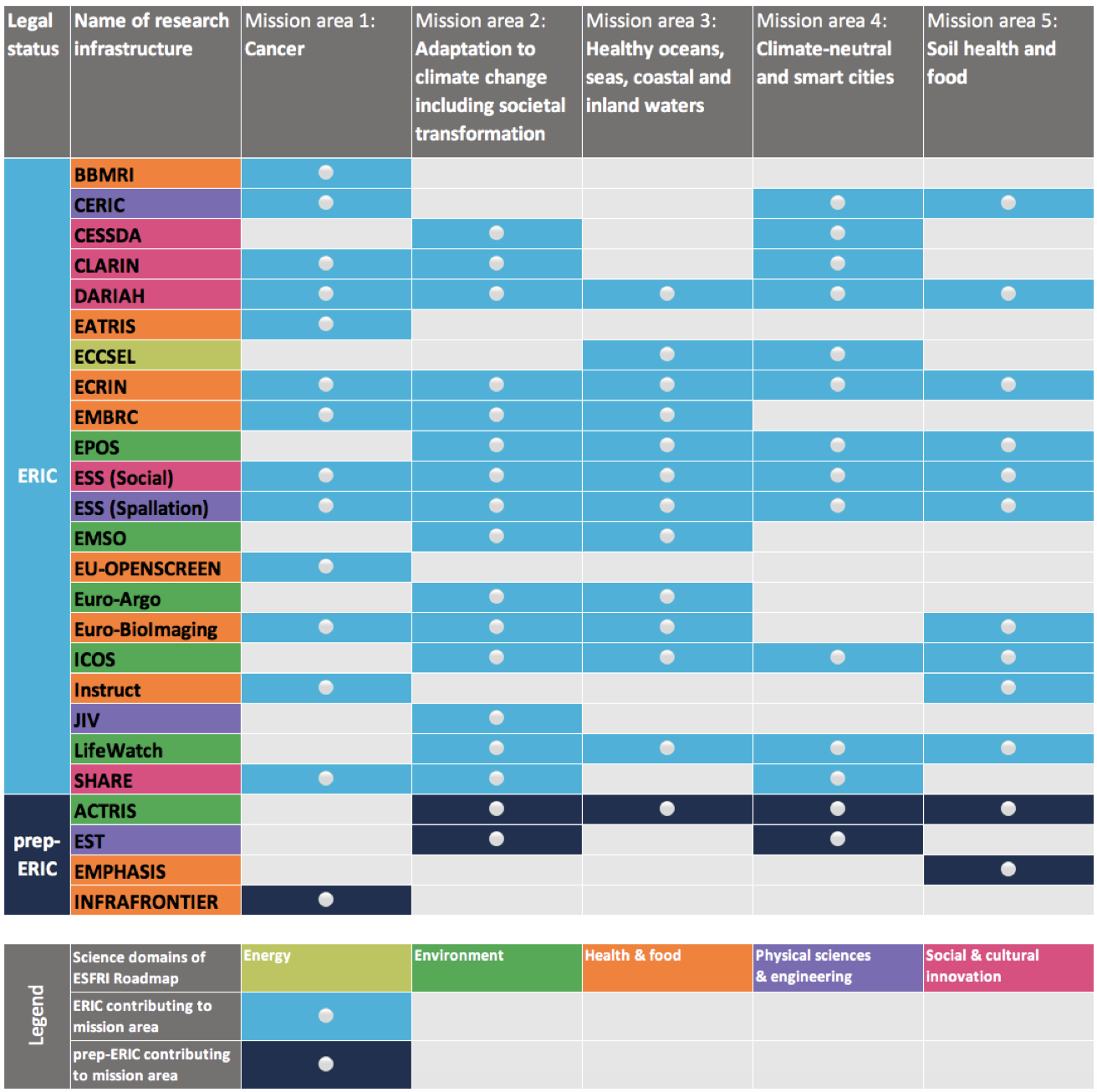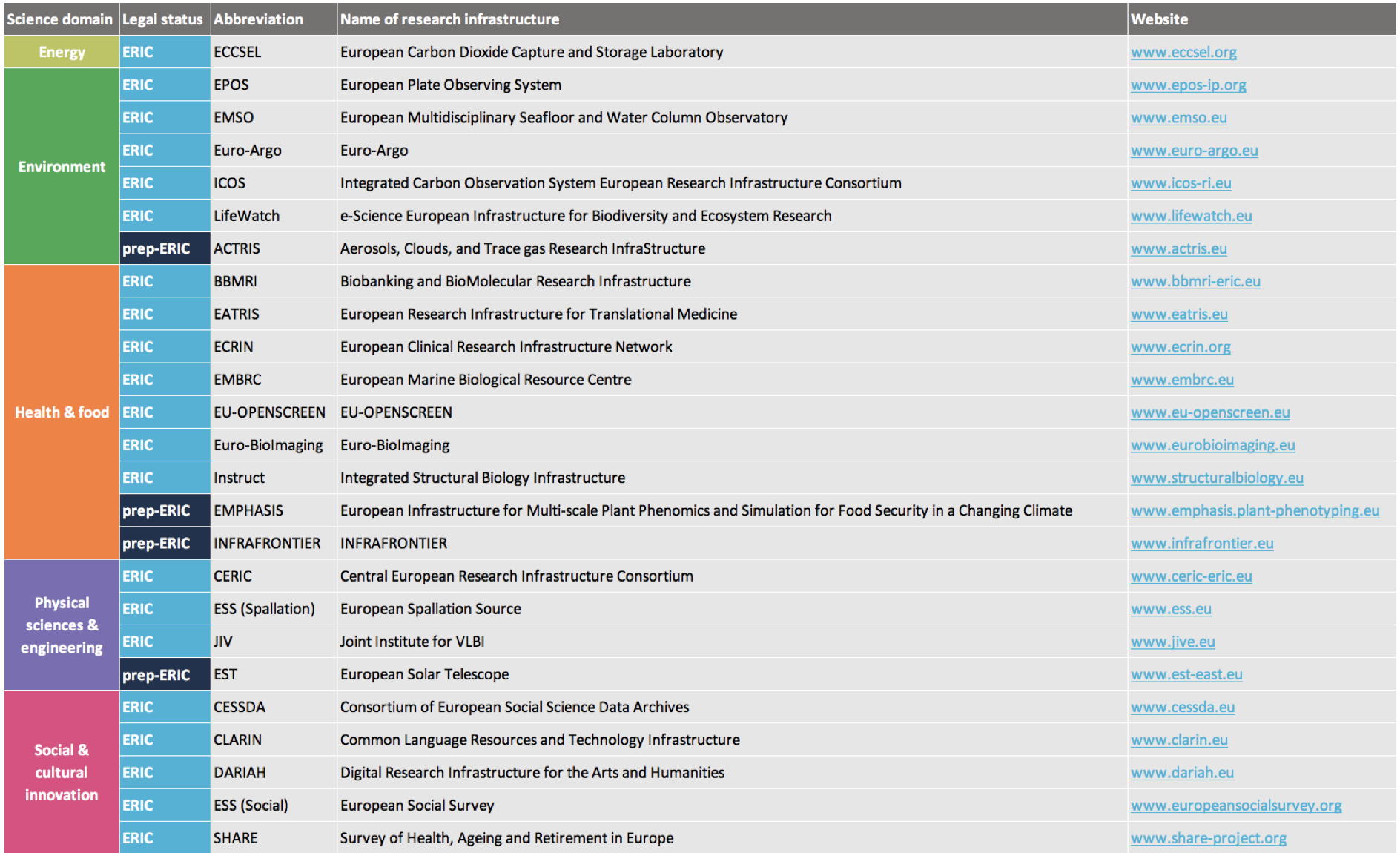–
ERICs as facilitators of excellent science benefiting society
The legal framework for a European Research Infrastructure Consortium (ERIC) was introduced in 2009 to facilitate the establishment and operation of large-scale research infrastructures of European interest. The first ERIC was subsequently founded in 2011, in the Netherlands. The ERIC community has been expanding ever since. Until now, 21 ERICs have been established with their respective host seats in 10 different European states. Having around 12 member countries on average, each ERIC is a truly international endeavour.
 The fast growth of the ERIC community in the last nine years bears testimony to the importance of the ERIC legal framework for European science and innovation. Research infrastructures aspiring to become an ERIC (currently 11 of them) must demonstrate their added value for the European Research Area (ERA) in a complex application process that – once successfully completed – leaves no doubt as to the scientific excellence of the ERIC. Each ERIC represents a leading international research organisation in their respective domain, and facilitates excellent scientific research by providing access to high-quality data and cutting-edge instrumentation. ERICs are critical elements of the ERA.
The fast growth of the ERIC community in the last nine years bears testimony to the importance of the ERIC legal framework for European science and innovation. Research infrastructures aspiring to become an ERIC (currently 11 of them) must demonstrate their added value for the European Research Area (ERA) in a complex application process that – once successfully completed – leaves no doubt as to the scientific excellence of the ERIC. Each ERIC represents a leading international research organisation in their respective domain, and facilitates excellent scientific research by providing access to high-quality data and cutting-edge instrumentation. ERICs are critical elements of the ERA.
The ERIC community is diverse and covers five different research domains of the European Strategy Forum on Research Infrastructures (ESFRI) Roadmap – namely energy, environment, health and food, physical sciences and engineering, and social and cultural innovation. While being diverse, ERICs are united in their vision to carry out research programmes that contribute to the development of a variety of scientific and technological fields, strengthening Europe’s global position in research and innovation, and improving the life of European citizens. The ERICs also work together within the framework of the ERIC Forum – a platform established to intensify collaboration and collectively develop responses to common challenges. Much of the science enabled by ERICs addresses the United Nations (UN) Sustainable Development Goals (SDG), tackles grand societal challenges, and contributes to research aimed at combating global threats such as the COVID‑19 pandemic. This paper further describes how the ERIC Forum together with four preparatory ERICs[1]contribute to the mission areas currently being developed in preparation for the next European Union’s Research and Innovation Framework Programme, Horizon Europe.
—
Table showing which ERIC/prep-ERIC contributes to which Horizon Europe Mission Area

–
Mission area 1: Cancer
–

Photo by Hal Gatewoodon Unsplash
High quality, goal-oriented research is key to unravelling the causes of cancer and developing preventive actions. It allows scientists to understand the course of disease in its manifold forms, and design targeted therapies for effective treatment. The ERICs have a real impact on this mission and help to deliver solutions through multi-disciplinary research and development of this kind. These contributions are not limited to ERICs from the life sciences area and combine with physical sciences and engineering to help researchers to understand protein structures and their folding. This allows for rational drug design, which consequently leads to more selective drugs that display fewer unintended side effects. On the other hand, social and cultural innovation is a key element in the strategy to beat cancer. An effective prevention strategy relies heavily on the insights generated by research in social sciences and humanities, for example by the understanding of lifestyle and environmental factors that contribute to, or protect from, the onset of cancer.
The rich catalogue of ERIC services across all scientific domains ensures that relevant research questions can always be addressed using state-of-the-art technologies, validated in vivo, in vitro and in silico research models, well-annotated (biological) resources, and high-quality data. Cutting-edge technologies, such as high-throughput screening, chemoproteomics, nuclear magnetic resonance (NMR), cryo-electron microscopy (cryo-EM), Accelerator Mass Spectrometer microdosing studies (AMS) as well as access to biobanks and marine biology resourcesare necessary for development and characterisation of anti-cancer drugs. Access to animal models for the study of genotype-phenotype interactions and the validation of novel therapies are essential in the drug design and development processes.The combination of molecular analysis technologies with advanced medical and biological imaging methods will yield in-depth understanding of the mechanisms governing the development of tumor cells and their spread into tissues. It will also enable identification and validation of both preventive measures and new therapeutic targets.
Further to the above, the drug discovery and development process benefits greatly from the rich diversity of the marine ecosystem, which has a proven track record as a source of novel treatments and pharmaceutics for cancer and other diseases. Here also, ERICs contribute to the knowledge and resources utilised therein.
ERICs are valuable support instruments in the study of underlying disease mechanisms, too. For instance, identification of homogenous clusters of patients through biomarker profiling provides key information on disease mechanisms. Clinical confirmation of underlying biological variations leads to validated biomarkers used as a targeting mechanism for future therapies. This is an elemental principle in personalised medicine. The clustering is often first hypothesised on the basis of social, economic and health data. Such data allows researchers to compare actual health conditions to subjective perceptions. Thanks to the longitudinal character of data (generation 50+ in Europe), researchers can assess trends over time and follow up the history of disease and the long‑term consequences of treatment options.
In pharmacology and biotechnology, the ERICs also play an important role. This includes understanding the biological functions of proteins, improving drug delivery methods and technologies behind cancer diagnosis and treatment, developing non-invasive diagnostic methods, following up the real-time efficacy of a given treatment, as well as developing new biomaterials to be used in cancer surgery and post-operative care.
Even the study of language itself is of value for cancer research. The understanding of speech disorders and their underlying causes can lead to better diagnosis of patients suffering from diseases such as brain cancer, especially in combination with brain images and clinical data. If well captured, such knowledge can add to the diversity of signals considered in the discovery of patterns of causation and the evaluation of the effectiveness of medical interventions.
Finally, the field of fine art can too contribute to the complex value chain of cancer research and development by outreach, popularisation of science, and creation of relevant, strong values. Evidence in literature, history and the arts regarding body-mind relationships, perceptions of illness and wellness, as well as history of medicine and science can all provide valuable insights which lead to better understanding of the interplay between physical and mental effects of cancer.
ERICs from four different scientific domains provide highly valuable contributions to the complex endeavour that is the battle against cancer. Professional access to cutting-edge analytical technologies, scarce biological and technical resources, world-leading expertise and high-quality data are essential tools at Europe’s disposal. The activities of ERICs that are relevant to the cancer mission reach beyond the borders of Europe as many of the ERICs have built international networks and have global influence. Hence, the ERIC community can both boost the existing global partnerships and support the establishment of new ones across various fields and topics relevant for cancer research and treatment. We welcome the opportunity to engage with the highly motivated research teams of the cancer mission.
–
Mission area 2: Adaptation to climate change including societal transformation
–

Photo by Andy Falconeron Unsplash
Climate change is a global challenge. International cooperation and coordination built on expertise and data from all research domains is needed to tackle the phenomenon in an effective way and to bring about societal transformation. Nearly 65% of the ERICs and prep-ERICs contributing to this position paper have indicated their ability and readiness to contribute to the achievement of this mission.
The COVID-19 crisis has shown that we must be able to act fast. Although climate change is on a different timescale and does not evolve as rapidly as the current pandemic, its effects will be long-term. Moreover, once the current ecosystem enters a new stage, it will be impossible to switch back. Rapid and easy access to information is crucial to prepare mitigation strategies for reducing or minimising harmful effects. We must improve our ability to respond adequately to the main challenges related to climate change.
Topics that the ERIC community can help to monitor and analyse include:
- Weather services: Monitoring climate, data used by weather prediction services and space weather services,
- Biodiversity and ecosystems: Monitoring ocean warming (physical and ecosystem) and aspects like temperature, salinity, nutrients, or concentration of greenhouse gases, such as methane or carbon dioxide,
- Pollutants and emissions: Developing high-precision and long-term greenhouse gases observations, including satellite observations,
- Human health: Providing data on infectious diseases triggered by climate change and their increased occurrence,
- (Pre-)clinical research: Providing open access to cutting-edge imaging technologies, training and data services in biological and biomedical imaging in order to enable the understanding of the mechanisms of new diseases as early as possible,
- Language resources, literature and social media: Analysing policy documents, changes in attitudes and behaviour,
- Social transformation: Tracking awareness on urgent behavioural changes needed to mitigate the consequences of climate change.
In order to effectively contribute to the mission on climate change, research infrastructures must be able to make relevant data findable according to the FAIR principles, and ensure that the (meta)data are readable by humans as well as machines. The ERIC community recognises the need to provide adequate metadata – based on common standards – and develop semantic techniques to connect these data and make them interoperable. In addition, the data should be shared for a safe exploitation of microdata combined with geophysical and geological data. For example,data on health histories can be linked to meteorological data by time and location. By expanding modelling tools, ERICs will be able to analyse how for example pollutants affect the environment, what needs to be done to optimise catalysis for cleaner air and water, identify causal links between an environmental policy and environmental, economic, or health-related outcomes, and last but not least advance biomedical research, bio-image informatics and machine-learning approaches.
The diversity of the ERIC community positions it well to contribute to solutions that help to address climate change and support necessary societal transformation. For example, the research enabled by ERICs helps to improve the technology underpinning batteries, wind energy, and solar energy, and consequently decreases dependency on fossil fuels. By developing better materials, scientists using the technology, services and data provided by ERICs optimise manufacturing of plastics and reduce the negative impact of plastics on the environment. Materials research also helps scientists to understand the lifespan of concrete, and investigate materials for carbon capture and storage, including metal-organic frameworks. ERICs deepen our knowledge of the role of marine biodiversity in climate regulation and the impact of climate change on marine biodiversity. In addition, the studies conducted in social sciences and humanities help us to understand relationships between people and their behaviour over time and especially when they are confronted with a common crisis. This can raise awareness among people about the impact of climate change and structurally change their behaviour.
To sum up, the science enabled by ERICs contributes to the creation of new knowledge, provides evidence for smart and informed strategic decisions, and supports the transformation to sustainable (and circular) economic systems.
A dynamic interplay between technology development, adequate monitoring, setting up viable circular economies and persistent change of human behaviour can lead to an effective and structural adaptation to climate change. In order to achieve this, we must join forces – over scientific disciplines, over continents, and over cultures. In this regard, the ERIC community has already laid a strong foundation by bringing together research infrastructures from various scientific domains and connecting researchers from their broad international member bases.
–
Mission area 3: Healthy oceans, seas, coastal and inland waters
–

Photo by Andrzej Kryszpiniukon Unsplash
Aquatic systems, such as the oceans, regional seas, transitional and inland waters provide unlimited resources and services to mankind. Their health and the well-being of the human communities living by these systems are closely interconnected and depend upon each other. Our aquatic ecosystems face tremendous risks because of a multitude of anthropogenic stressors, including climate change. They are in continuous exchange of energy and material with systems of the atmosphere and land. The levels at which aquatic systems are organised are complex and the scales of their observations are enormous. This is one of the reasons why they are insufficiently explored. Multi-disciplinary research is needed in order to identify and implement effective responses to current risks.
A global scientific agenda on ocean and human health is currently being designed. This endeavour requires coordinated efforts by the scientific community, stakeholders, policy makers and the general public. The agenda forms part of the upcoming United Nations (UN) Decade of Ocean Science for Sustainable Development (2021–2030). The European Union (EU), compliant to its obligations to the UN, has already planned a series of funding instruments for its Horizon Europe umbrella programmes, such as clusters, missions, European Research Council (ERC) grants etc. These programmes provide the research and academic community with means needed to advance science, technology and innovation and generate science-based knowledge that EU needs not only to address the UN agendabut also to tackle its own priority societal challenges: clean energy, sustainable industry, biodiversity, pollution combat, to cite just a few.
Undoubtedly, such ambitious goals and grand challenges require the support of the entire ERIC community united in a cross-domain approach from which no discipline is excluded. The key ingredients to success are: access to open data, reproducible analytics and mobilised communities. A vast number of services are needed in order to tackle current and future challenges. The modelling of Earth surface and sea bottom alterations helps to predict and assess the impact of natural phenomena, such as for example earthquake or tsunami, on the environment, society (anthropogenic environment), and security (e.g. Fukushima nuclear power plant accident). The research facilitated by ERICs helps to combat and mitigate the effects of human activities, such as overfishing, greenhouse gas emissions, threats to biodiversity, marine pollution, including plastics and oil spills, and the introduction of invasive species, which are all threats to marine and coastal biodiversity, worldwide. These activities may happen in isolation or in concert with the natural processes. By applying marine bio-based and sustainable solutions in food (aquaculture, food supplements etc.) and health research (new medication, treatments, health supplements, cosmetics etc.) the ERICs foster Europe’s blue bio-economy. In this respect, aquatic biodiversity is a huge source of new molecules with tremendous potential therapeutic effect. Research infrastructures also play a crucial role in revealing detailed characteristics of water under extreme conditions and various natural environments. This supports the efforts towards improving surfactants, catalysts and compounds used in mining. An efficient use of agricultural resources potentially reduces their impact on the blue environment. The ERICs facilitate research that aims to protect and preserve ocean health. This includes collecting data on raising sea levels, exchange of energy between the ocean and atmosphere, primary production of ocean acidification, deep ocean circulation, and ecosystem restoration. The linguistic resources generated by ERICs contribute to improved ocean literacy and better understanding of life in oceans and its impact on society.
The ERICs and other research infrastructures whose research activities are directly linked to and relevant for the aquatic systems have formed an alliance and declared their determination to help Europe to fulfil its goals relevant to this mission by effectively using the funding instruments that will be made available through Horizons Europe (Athens Declaration, January 2020). This approach will not only aim to improve the health of the aquatic ecosystems but also support the EU in meeting its obligations relative to UN priorities. As international organisations supported by strong and wide research networks, the ERICs are well-positioned to make significant contributions to the successful implementation of the mission on healthy oceans, seas, and coastal and inland waters.
–
Mission area 4: Climate-neutral and smart cities
–

Photo by Osman Rana on Unsplash
In December 2019, the Mission Board for climate neutral and smart cities submitted to the European Commission a scoping paper with its vision for the prospective Horizon Europe mission. The paper argued the mission should “support and promote 100 European cities in their systemic transformation towards climate neutrality by 2030”. The Board proposed a multi-level, co-creative process by and for the citizens. It is to be formalised through Climate City Contracts, which would offer cities financial means to achieve the mission goals through Horizon Europe and other EU instruments. The mission should help in delivering the SDG by improving air quality, creating jobs, promoting healthier lifestyles, and reducing the negative effects of mobility. In addition, the mission is to significantly contribute to the goal of achieving Europe’s carbon neutrality by 2050 as envisaged by the European Green Deal, which will allow for upscaling of the results to all European cities.
ERICs, as pan-European, mostly distributed research infrastructures acting in various domains from physical sciences, engineering, energy, health and food, environment, to social and cultural innovation, jointly offer a unique opportunity to support the delivery of the proposed mission.
ERICs will contribute indispensable data linked to societal transformations brought about by the shift to carbon neutrality. They survey and provide access to data about governance, mobility, attitudes towards climate measures, energy use, fear of crime, sense of safety (tolerance), identity of cities, role of civil society, wider information and communications technology (ICT) usage and similar. In addition, the ERICs collect sociodemographic data that helps to understand older people’s quality of life and factors that influence it. This includes for example information about how their social networks are utilised to provide care and support, the prevalence of loneliness and depression, or matters of mobility and inclusion. Focusing on the cities as places that embrace multilingualism, ERICs will further contribute to inclusiveness of smart cities, accessible without language barriers, through machine translation, text-to-speech, speech-to-text, data literacy and data empowerment. Randomised interventional studies will allow definition of causal links between a given public policy, change in behaviour, lifestyle or equipment on the one hand, and environmental, economic, wellbeing, and health on the other hand. Studies of digital methods and good practices of heritage and urban change and impact of urban development on cultural heritage will further contribute to the quality of life and the economy of the cities.
As human population is being concentrated into big urban areas, it impacts urban biodiversity and the surrounding ecosystems. Studies about the impacts of changes in the use of land and water resources on biodiversity and ecosystems will contribute to healthier and liveable cities.
Methods for quantifying greenhouse gas emissions and sinks, and the collection of emissions data will become important tools for policy makers. The ERICs will also provide support and access to scientists who develop and integrate technologies to detect urban greenhouse gas fluxes. Furthermore, observations on aerosol concentrations, chemical composition and optical properties will contribute to the understanding on public health through aerosol particles and gases which, at concentrations typically found across Europe, give rise to severe and unacceptable health effects in the population.
ERICs will also contribute to the development of technologies in support of the transition towards carbon neutrality, particularly in the fields of green energy and energy storage, but also carbon capture and utilisation (e.g. conversion), energy efficient materials, and similar. By offering techniques based on photons, neutrons, ion beams, electrons and NMR, they are particularly well-suited to support the development of these technologies. Their achievements in the field range from the use and storage (CCUS) technologies, green technologies implemented in the energy and industry sector to reduce and neutralise CO2emissions in cities and close to them, improvement of mobility with better batteries, longer lasting solar cells, more efficient wind turbines and power grids, to name a few. The contribution of these facilities to the objective of carbon neutral cities will also entail reduction of their own carbon footprint. The excellent science and research results enabled by the ERICs with the aim to contribute to the successful implementation of the mission on climate-neutral and smart cities will not only improve the lives of citizens, but also strengthen Europe’s position on the global science map.
–
Mission area 5: Soil health and food
–

Photo by Jean Wimmerlin on Unsplash
By providing multiple services to address challenges relating to soil health and food, ERICs are able to contribute to the European Commission’s Green Deal in a very unique manner. ERICs have the relevant competences and provide technologies, facilities and knowledge from a wide range of areas. They enable our society not only to sustain soil as the key foundation of a healthy food system, but also to use it in a feasible way to grow plants that can be turned into products such as textiles or paper.
ERICs help to intensify crop production in a sustainable way by ensuring that plant biomass and other crops are produced in sufficient quantity and meet the necessary nutritional quality standards. To that end, ERICs will play an important role in relieving the bottleneck for sustainable and improved crop production that will be required by new agro-climatic scenarios – current and future. A key question in this respect is: How to translate from high-throughput genotypic analysis of crop variants to high-throughput and high-resolution phenotyping in order to identify high-yield crop varieties for defined environmental conditions?
The ERIC community further helps to elucidate the high complexity of soils and their interactions with the surrounding environment on all levels. This includes the micro-biological level, enabling solutions to restore the functionality of soils exposed to extreme conditions, such as intensive culture, sea level rise and climate change. Research of marginal soils that are abundant at open-pit mining sites in Europe helps to generate knowledge on restoring soil health and its specialised usage for plant biomass production. Complementary services are provided by materials science, which covers soil abiotic processes of high relevance for soil functions and food production, e.g. regarding the behaviour of trace metals.
Soil health and food production is strongly connected to cultural aspects. ERICs generate new knowledge on the causalities and impact of human civilisation on natural ecosystems, agricultural sites, biodiversity and climate. Their expertise and services also cover the relationship between humans and their agricultural environment in the context of increasing ecological awareness and behavioural changes in dietary habits.
The activities of ERICs relating to soil health and food go beyond the geographical scope of Europe. In this way, the ERIC community can act as a nucleus or stimulator of global partnerships across various fields and topics, creating links between for example biodiversity, agronomy and forestry. The ERICs form a strong basis for tackling the global challenges on soil health and food and for keeping European science at the forefront.
–
Overview with full names and website addresses of ERICs/prep-ERICs contributing to this position paper

[1]This report is based on input provided to the ERIC Forum by 21 ERICs and 4 preparatory ERICs. All established ERICs (21) and preparatory ERICs (11) were invited to contribute.
–